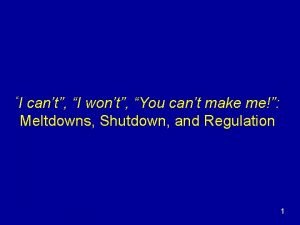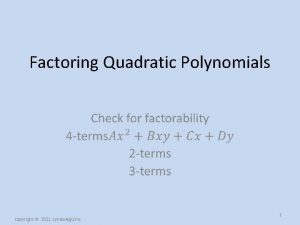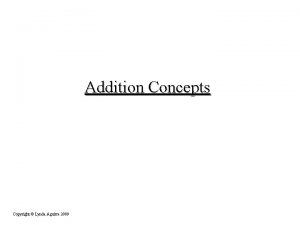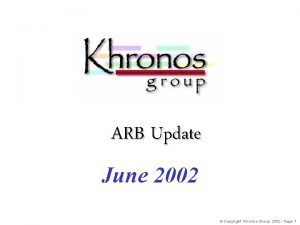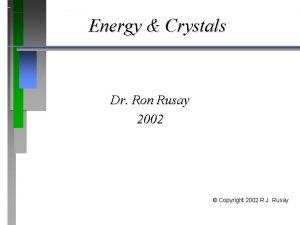copyright c Lynda Greene 2002 1 Complete the
























- Slides: 24

copyright (c) Lynda Greene 2002 1

Complete the Square Copyright© 2002 Lynda Greene copyright (c) Lynda Greene 2002 2

Completing the Square This process is used on Quadratic (or 2 nd power) trinomials. CONCEPT: What are we doing and Why? 1. If normal factoring methods don’t work, we can alter the problem to create a new trinomial that can be factored. OR 2. When we need to draw a graph, the equation can be changed into the (factored) Standard Form: Note: Completing the Square is used mainly for graphing parabolas, but it can also be used to graph conic sections, such as circles, ellipses, and hyperbolas which also have 2 nd powers. copyright (c) Lynda Greene 2002 3

Completing the Square Note: There are two major methods for doing the process of Completing the Square. 1. Same Side - which is what we are doing in this lecture -----works on Equations and Expressions. 2. Different sides - which is in most textbooks ----works only on Equations and then you have to switch back to the “Same Side” method if the problem is an Expression. Definitions: EQUATION: problem with an equal sign (=) in it EXPRESSION: problem that does not have an equal sign in it copyright (c) Lynda Greene 2002 4

Completing the Square STEP 1: SEPARATE TERMS Factor x 2 + 6 x – 9 We begin by separating the three terms into two groups. 2 x + 6 x The first group has the first two terms in it and will become a new trinomial – 9 The second group will have the constant in it. copyright (c) Lynda Greene 2002 5

Completing the Square Factor 2 x + 6 x – 9 STEP 2: CREATE BLANK SPACES FOR THE NEW 3 RD TERM AND THE BALANCING TERM 2 (x + 6 x + ___ ) – 9 - ___ Create a blank space Create another blank space for the new 3 rd term. for the “balancing term” (Draw parentheses around this new trinomial) Notice that the signs are opposites. 3 RD TERM: + BALANCING TERM: - copyright (c) Lynda Greene 2002 6

Completing the Square STEP 3: CREATE THE FACTOR 2 (x + 6 x + ___ ) – 9 - ___ Side Calculation: Take half (x 1/2) of the coefficient of the middle term Write this underneath the trinomial. (This is the FACTOR) Write this number in the FACTOR Think of it as: Half of positive 6 is positive 3 copyright (c) Lynda Greene 2002 7

Completing the Square STEP 4 A: CREATE THE 3 rd TERM 2 (x + 6 x ) – 9 - ___ Write the new 3 rd term in the trinomial Side Calculation: Use FOIL to find the new 3 rd term See lesson on Perfect Square Trinomials and FOIL multiplication for details about this process copyright (c) Lynda Greene 2002 8

Completing the Square STEP 4 B: WRITE THE BALANCING TERM – 9 - ___ Write the same number in the balancing term copyright (c) Lynda Greene 2002 9

Completing the Square STEP 5: COMBINE THE CONSTANTS Add (or subtract) the CONSTANT and the BALANCING TERM You can drop either of these two terms if they are zeros. copyright (c) Lynda Greene 2002 10

Here are some step-by-step examples of typical problems. Separate into two groups Create spaces for the 3 rd term and the balancing term Create the FACTOR Factor: x 2 + 8 x – 7 ( x 2 + 8 x + ____) – 7 - (____) (x + 4)2 It is also the balancing term FOIL the factor: 8 ( ½) = 4 This is the 3 rd term copyright (c) Lynda Greene 2002 11

Continuing… (x 2 + 8 x + 16) – 7 - 16 (x + 4)2 - 23 Combine the Constants If you need to draw a graph this is where you stop -7 -16 = -23 If you have an equation (=) and need to solve for x, continue working until x is by itself (isolated) copyright (c) Lynda Greene 2002 12

Factor: x 2 + 10 x – 7 1. Separate terms (x 2 + 10 x 2. Create Blanks 3. Create Factor 2 (x + 5) rd 4 A. Foil to find 3 term 4 B. Fill in blanks 5. Add Constants + 25) – 7 - (+ 25) FOIL: (x + 5) = (x 2 + 10 x + 25) Fill in the 2 blanks (x + 5)2 – 7 – 25 (x + 5)2 – 32 Note: You can take a shortcut and avoid the FOIL step by squaring “half the middle term” (i. e. copyright (c) Lynda Greene 2002 13

Factor: x 2 - 3 x + 2 1. Separate terms (x 2 - 3 x + 2. Create Blanks 3. Create Factor 2 (x – 3/2) rd 4 A. Foil to find 3 term, or square it 4 B. Fill in blanks 5. Add Constants 9/4 ) + 2 - (+ 9/4) Square it: Fill in the 2 blanks (x – 3/2)2 + 2 – 9/4 (x – 3/2)2 – 1/4 Use “common denominators” to add fractions copyright (c) Lynda Greene 2002 14

Factor: x 2 - x - 4 1. Separate terms (x 2 - 1 x + 2. Create Blanks 3. Create Factor 2 (x – 1/2) rd 4 A. Foil to find 3 term, or square it 4 B. Fill in blanks 5. Add Constants 1/4 ) - 4 - (+ 1/4) Square it: Fill in the 2 blanks (x – 1/2)2 - 4 – 1/4 (x – 1/2)2 – 17/4 Use “common denominators” to add fractions copyright (c) Lynda Greene 2002 15

Note: If there is a coefficient in front of the first term Extra Step*: You must factor it out of the first two terms before completing the square. Separate terms and draw spaces *Factor the 2 out of the 1 st group Factor: 2 x 2 + 6 x – 7 = 0 (2 x 2 + 6 x + ____) – 7 - ____= 0 2(x 2 + 3 x+___) – 7 - ___ = 0 2(x + 3/2)2 Take half of the middle coefficient copyright (c) Lynda Greene 2002 16

Factor: 2 x 2 + 6 x – 7 = 0 2(x 2 + 3 x +__ 9/4) – 7 - ( 9/4) ___ = 0 2(x + 3/2)2 Square it: So, the third term we created was a 9/4 Write it in the inside both blank spots. copyright (c) Lynda Greene 2002 17

Factor: 2 x 2 + 6 x – 7 = 0 2(x 2 + 3 x + 9/4 ) – 7 - 2(9/4) = 0 But, the number in the parentheses, 9/4, is being multiplied by 2 So the number we actually added to the left side is not 9/4, It is 2(9/4) = 9/2. 2(x + 3/2)2 - 7 – 9/2 = 0 2(x + 3/2)2 - 23/2= 0 Now add the constants copyright (c) Lynda Greene 2002 18

Completing the Square: Solving for x 2(x + 3/2)2 - 23/2= 0 Add 23/2 to both sides: 2(x Divide by 2: 2(x + 3/2)2 = 23/2 + 3/2)2 = 23 2 4 Take the square root of both sides: Subtract 3/2 from both sides: x + 3/2 = copyright (c) Lynda Greene 2002 19

Note: If there is a negative coefficient in front of the first term, you must factor it out of the first two terms and change the signs. Separate and draw spaces Factor: -3 x 2 + 6 x + 4 = 0 Factor the -3 (-3 x 2 + 6 x + ____) + 4 - _____ = 0 out of the 1 st This changes the signs on 1 st two terms inside the ( ) group -3(x 2 - 2 x + ___) + 4 +3 ( )= 0 SIGNS!!! Since the parentheses has a -3 in front of it, the balancing term will have a +3 in front of it You can think of the balancing term as: - (-3)( ___) copyright (c) Lynda Greene 2002 20

Factor: -3 x 2 + 6 x + 4 = 0 -3(x 2 - 2 x + 1 ) + 4 + 3 (+ 1 ) = 0 Take half of the middle coefficient Add the constants -3(x - 1)2 Square it -3(x - 1)2 + 4 + 3 = 0 -3(x - 1)2 + 7 = 0 So, the third term we created was a 1 Write it in the inside both blank spots. copyright (c) Lynda Greene 2002 21

Completing the Square: Solving for x -3(x - 1)2 + 7 = 0 Subtract the 7 from both sides: -3(x - 1)2 = -7 Divide by -3: -3 -3 Take the square root of both sides: Add 1 to both sides: x -1+1= 1 copyright (c) Lynda Greene 2002 22

You can’t have a square root on the bottom of a fraction So we have to rationalize the denominator Now our solution is: copyright (c) Lynda Greene 2002 23

Now depending on your teacher’s preference and the textbook you are using, this may be the way the answer is written. Answer: or Notice that this answer has a “ 1” separated from the fraction by the plus-minus sign. This can be changed into a single fraction by changing the “ 1” into a fraction with a common denominator and then adding the two fractions together. Rewrite. Multiply the “ 1” the top and bottom by Rewrite it as 3 fraction single fraction to as getathe same denominator as the aother fraction copyright (c) Lynda Greene 2002 24
 Copyright 2002
Copyright 2002 Copyright 2002
Copyright 2002 Robert greene shakespeare
Robert greene shakespeare Collaborative problem solving plan a b c
Collaborative problem solving plan a b c The destructors character analysis of trevor
The destructors character analysis of trevor Uzuri pease-greene
Uzuri pease-greene Arin greene
Arin greene Kylie greene
Kylie greene Maxine greene releasing the imagination
Maxine greene releasing the imagination Adaptive challenges examples
Adaptive challenges examples Robin dunkin ucsc
Robin dunkin ucsc Linda r greene
Linda r greene The tenth man graham greene summary
The tenth man graham greene summary Eric greene course
Eric greene course Ericka greene md
Ericka greene md Journey without maps
Journey without maps Problem solving plan (plan b flowchart)
Problem solving plan (plan b flowchart) Greene's theorem
Greene's theorem Auditory digital
Auditory digital Lynda dias
Lynda dias Slq lynda
Slq lynda Aquila clemmons
Aquila clemmons Unt microsoft office download
Unt microsoft office download Lynda vpl
Lynda vpl Zdalny pulpit
Zdalny pulpit



